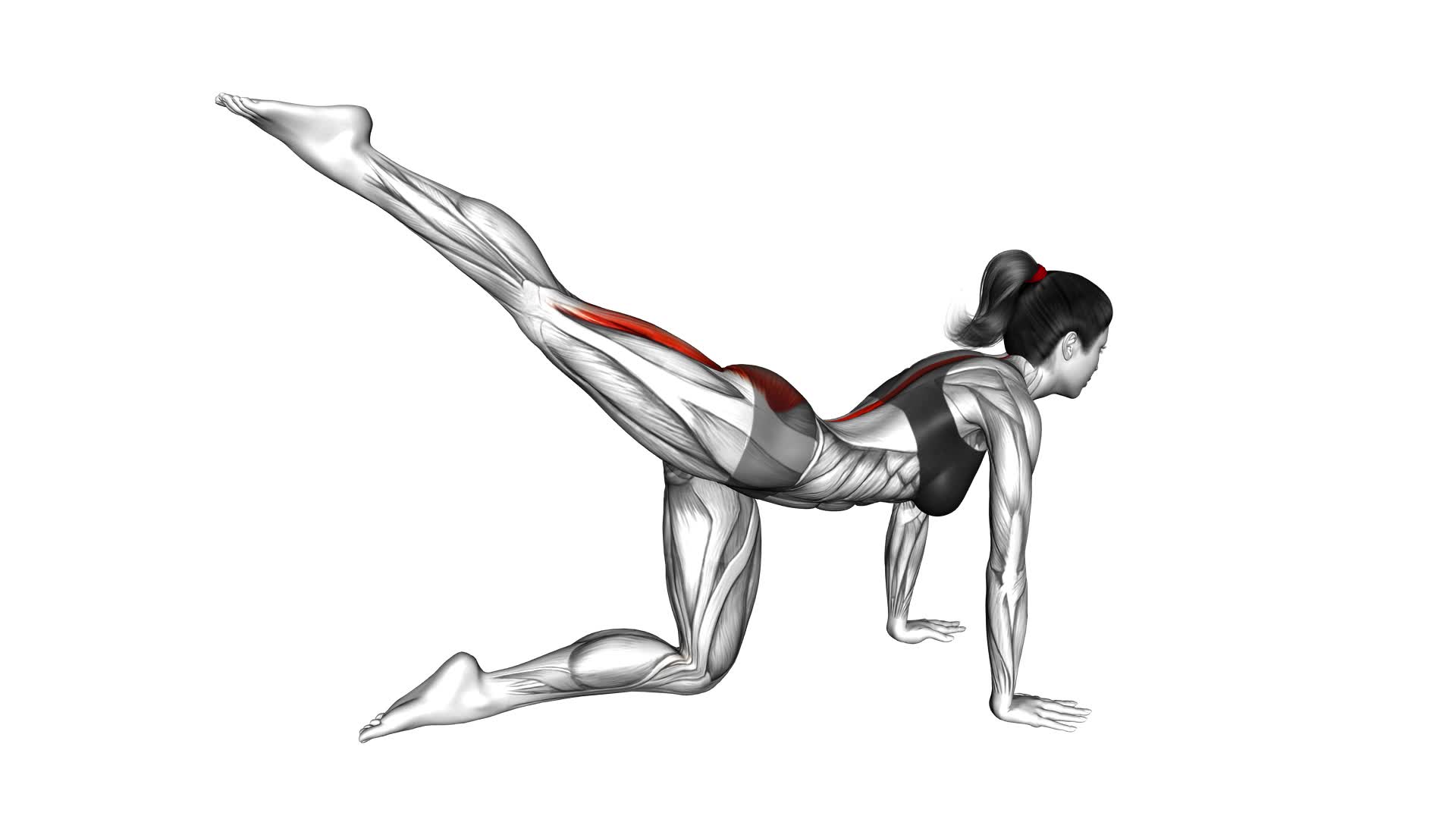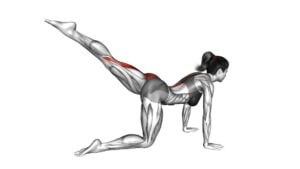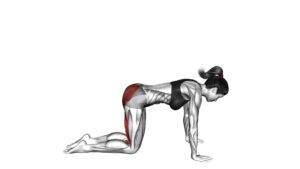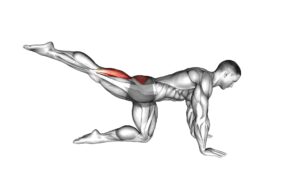Kneeling Straight Leg Kickback (VERSION 2) (female) – Video Exercise Guide & Tips

Get ready to tone and strengthen those glutes with the Kneeling Straight Leg Kickback (Version 2). This exercise is perfect for females looking to target their backside.
Watch This Exercise Video
In this video exercise guide, we'll show you the proper form and technique to get the most out of each kickback. Plus, we'll give you tips to maximize effectiveness and avoid common mistakes.
It's time to kick your fitness goals into high gear. Let's get started!
Key Takeaways
- Increased glute strength
- Improved lower body stability
- Alleviates knee pain
- Promotes better knee alignment
Benefits of the Kneeling Straight Leg Kickback (VERSION 2)
You will experience increased glute strength and improved overall lower body stability with the kneeling straight leg kickback (version 2). This exercise isn't only effective but also beneficial for individuals dealing with knee pain. By activating the glutes, you can alleviate stress on the knees and promote better knee alignment during movement.
When performing the kneeling straight leg kickback (version 2), your glutes are engaged throughout the entire range of motion. This targeted activation helps to strengthen the glute muscles, which are essential for maintaining proper lower body function and stability. Strong glutes can provide support to the surrounding muscles and joints, including the knees, reducing the risk of pain or injury.
Furthermore, this exercise helps improve overall lower body stability. As you kick your leg back, you engage your core and stabilizing muscles to maintain balance and control. This enhances your ability to maintain proper form during various activities, such as running, jumping, or lifting.
Incorporating the kneeling straight leg kickback (version 2) into your workout routine can have a significant impact on your glute strength and lower body stability. Not only will it help alleviate knee pain, but it will also enhance your overall physical performance.
Proper Form and Technique for the Exercise
To ensure proper form and technique for the kneeling straight leg kickback (version 2), focus on engaging your glutes and maintaining control throughout the entire movement. Here's how you can perform this exercise correctly:
- Start by getting on all fours, with your hands directly under your shoulders and your knees under your hips. Keep your spine neutral and engage your core muscles.
- Extend one leg straight back, keeping it parallel to the floor. Your foot should be flexed, and your toes should be pointing towards the ground.
- Squeeze your glutes as you lift your leg higher, focusing on using your glute muscles to drive the movement. Avoid arching your lower back or relying on momentum.
- Slowly lower your leg back to the starting position, maintaining control and engaging your glutes throughout the entire range of motion.
Common mistakes to avoid during the kneeling straight leg kickback (version 2) include swinging the leg, relying on your lower back instead of your glutes, and not maintaining a neutral spine.
Tips to Maximize the Effectiveness of the Kickback
To maximize the effectiveness of the kickback, incorporate resistance bands or ankle weights into your workout routine. These additional forms of resistance will challenge your muscles even more, leading to greater strength and toning in your glutes and hamstrings.
When using resistance bands, secure them around your ankles and hold the other end with your hands. As you perform the kickback, you'll feel the resistance pulling against your leg, intensifying the exercise. Ankle weights can be strapped around your ankles and provide a constant resistance throughout the movement. Start with lighter weights and gradually increase as your strength improves.
In addition to adding resistance, it's crucial to maintain proper form and technique during the kickback. Keep your core engaged and your back straight throughout the exercise. Avoid arching your back or swinging your leg to generate momentum. Instead, focus on using your glutes and hamstrings to lift your leg straight back. Squeeze your glutes at the top of the movement to fully engage the muscles.
To further enhance the effectiveness of the kickback, try incorporating variations into your routine. Instead of lifting your leg straight back, you can angle it slightly outwards or inwards to target different areas of the glutes. You can also experiment with different tempos, such as slowing down the movement to increase time under tension.
Remember to always listen to your body and adjust the intensity as needed. By implementing these tips and techniques, you can make the most out of your kickback workout and achieve optimal results.
Modifications and Progressions for Different Fitness Levels
To cater to individuals of varying fitness levels, modifications and progressions can be made to the kneeling straight leg kickback exercise. Here are some exercise variations and ways to increase the intensity of the kickback:
- Beginner Modification: If you're new to this exercise or have limited mobility, you can start by performing the kickback with a smaller range of motion. Instead of fully extending your leg, focus on squeezing your glutes as you lift your leg slightly off the ground.
- Intermediate Variation: To challenge yourself further, you can add ankle weights or resistance bands to increase the resistance during the kickback. This will engage your glutes and hamstrings even more, giving you a more intense workout.
- Advanced Progression: For those looking for an advanced variation, try performing the kneeling straight leg kickback on an unstable surface, such as a stability ball or a Bosu ball. This will require more core stability and activate additional muscle groups, taking your workout to the next level.
- Plyometric Option: To add a cardio element to the exercise, you can incorporate a plyometric variation. Instead of simply lifting your leg, explosively kick it back and forth, alternating between legs. This won't only target your glutes but also increase your heart rate for a more intense calorie burn.
By modifying the exercise or progressing to more challenging variations, you can continually challenge your muscles and see improvements in strength and endurance.
Now, let's explore common mistakes to avoid while performing the kickback.
SUBSEQUENT SECTION: 'Common Mistakes to Avoid While Performing the Kickback'
Common Mistakes to Avoid While Performing the Kickback
One common mistake to avoid while performing the kickback is failing to engage your glutes fully. Proper form is crucial to ensure that you're targeting the right muscles and maximizing the effectiveness of the exercise. To avoid this mistake, focus on squeezing your glutes at the top of the movement. This will help you activate the muscles and get the most out of each repetition.
Another common mistake is using momentum to swing your leg up instead of relying on your glutes to perform the movement. Remember that the goal is to isolate and target the glutes, so it's important to perform the kickback in a controlled manner. Slow and controlled movements will give you better results and prevent you from relying on other muscles to compensate.
Additionally, avoid arching your back or rounding your shoulders during the kickback. This can put unnecessary strain on your lower back and compromise your form. Keep your core engaged and maintain a neutral spine throughout the exercise.
Frequently Asked Questions
How Many Sets and Reps Should I Do for the Kneeling Straight Leg Kickback?
To get the most out of the kneeling straight leg kickback, focus on doing multiple sets and reps. Start with 3 sets of 10 reps on each leg and gradually increase as you get stronger.
This exercise targets your glutes, hamstrings, and lower back, helping to improve your overall lower body strength and stability.
Don't forget to engage your core and maintain proper form throughout the movement for maximum benefits.
Keep pushing yourself and you'll see progress in no time!
Can I Do the Kneeling Straight Leg Kickback if I Have Knee Pain?
If you have knee pain, it's important to modify the kneeling straight leg kickback exercise.
You can try other glute exercises like glute bridges or hip thrusts, which put less stress on your knees.
Listen to your body and stop any exercise that causes discomfort.
Don't let knee pain discourage you, there are plenty of alternatives that will still help you strengthen your glutes and achieve your fitness goals.
Keep pushing forward!
Is It Normal to Feel a Burning Sensation in My Glutes During the Exercise?
Feeling a burning sensation in your glutes during the exercise is normal and actually a sign of good glute activation. It means that the muscles are working hard and getting stronger.
Embrace the burn and keep pushing through! Just make sure to listen to your body and stop if the burning sensation becomes too intense or painful. Remember, discomfort is expected, but pain is a sign to take a break and reassess your form.
Can I Use Ankle Weights to Make the Kneeling Straight Leg Kickback More Challenging?
To make the kneeling straight leg kickback more challenging, you definitely can use ankle weights. They add resistance and help to engage your glutes even more.
Ankle weights are also great for other leg exercises, like donkey kicks and fire hydrants.
If you're looking for alternative exercises for glute activation, try hip thrusts, Bulgarian split squats, or single-leg deadlifts.
Mix it up and keep pushing yourself to reach new levels of strength and tone in your glutes.
How Long Should I Hold the Contraction at the Top of the Kickback Movement?
To get the most out of your kneeling straight leg kickback, you want to make sure you're holding the contraction at the top of the movement for a few seconds. This helps to engage and strengthen your glutes even more.
Aim to hold the contraction for about 2-3 seconds before lowering your leg back down. Remember, the longer you hold, the more challenging it will be.
Conclusion
Incorporating the kneeling straight leg kickback (version 2) into your fitness routine can bring numerous benefits. One of the main benefits is strengthening your glutes. This exercise specifically targets the gluteus maximus, which is the largest muscle in your buttocks. By performing the kickback, you can effectively engage and activate this muscle, helping to increase its strength and size.
Another benefit of the kneeling straight leg kickback is improving hip stability. This exercise requires you to stabilize your hips and pelvis while extending your leg back. This can help improve your overall balance and stability, which is important for various daily activities and sports.
To maximize the effectiveness of the exercise, it's crucial to follow proper form and technique. Start by kneeling on all fours with your hands directly under your shoulders and your knees under your hips. Keep your core engaged and your back straight throughout the movement. Slowly extend one leg straight back, squeezing your glutes at the top of the movement. Lower your leg back down with control and repeat on the other side.
Remember to modify or progress the kickback based on your fitness level. If you're a beginner, you can start by performing the exercise without any additional weight. As you become more comfortable and stronger, you can add ankle weights or resistance bands to increase the challenge.
It's also important to be cautious of common mistakes. One common mistake is arching your back or rounding your shoulders. This can put unnecessary strain on your lower back and decrease the effectiveness of the exercise. Make sure to keep your core engaged and your back straight throughout the movement.
Stay motivated and committed to achieving your fitness goals with this powerful exercise. By incorporating the kneeling straight leg kickback into your routine and focusing on proper form and technique, you can strengthen your glutes, improve hip stability, and enhance your overall fitness level.

Author
Years ago, the spark of my life’s passion ignited in my mind the moment I stepped into the local gym for the first time. The inaugural bead of perspiration, the initial endeavor, the very first surge of endorphins, and a sense of pride that washed over me post-workout marked the beginning of my deep-seated interest in strength sports, fitness, and sports nutrition. This very curiosity blossomed rapidly into a profound fascination, propelling me to earn a Master’s degree in Physical Education from the Academy of Physical Education in Krakow, followed by a Sports Manager diploma from the Jagiellonian University. My journey of growth led me to gain more specialized qualifications, such as being a certified personal trainer with a focus on sports dietetics, a lifeguard, and an instructor for wellness and corrective gymnastics. Theoretical knowledge paired seamlessly with practical experience, reinforcing my belief that the transformation of individuals under my guidance was also a reflection of my personal growth. This belief holds true even today. Each day, I strive to push the boundaries and explore new realms. These realms gently elevate me to greater heights. The unique combination of passion for my field and the continuous quest for growth fuels my drive to break new ground.



